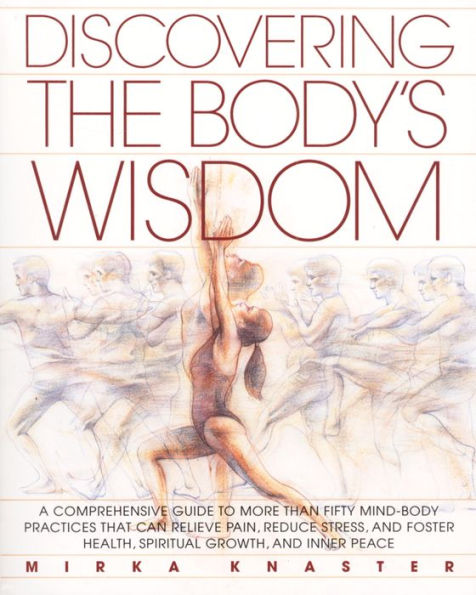Discovering the Body's Wisdom: A Comprehensive Guide to More than Fifty Mind-Body Practices That Can Relieve Pain, Reduce Stress, and Foster Health, Spiritual Growth, and Inner Peace
In an attractive, oversized format, enlivened with illustrations, sidebar quotes, personal accounts, techniques to try, and profiles of leaders in the field, Discovering the Body's Wisdom is a basic resource for well-being and natural health.
Body disciplines and therapies have enjoyed phenomenal growth in the past decade, becoming a major alternative to mainstream medicine and traditional psychotherapy. But with more than 100,000 practitioners and dozens of methods available in the United States alone, how can consumers choose the right one for themselves?
Mirka Knaster's richly informative guide provides an overview of the principles and theories underlying the major Eastern and Western body therapies, or "bodyways." It shows readers how to befriend their own bodies, getting back in touch with their internal sources of health and wisdom. It also describes more than 75 individual approaches, answering such questions as: How does each therapy work? What can we expect from one session or a series? What are the reasons for selecting this method? How do we find a qualified practitioner? What, if any, are the "consumer-bewares"?
1100619822
Body disciplines and therapies have enjoyed phenomenal growth in the past decade, becoming a major alternative to mainstream medicine and traditional psychotherapy. But with more than 100,000 practitioners and dozens of methods available in the United States alone, how can consumers choose the right one for themselves?
Mirka Knaster's richly informative guide provides an overview of the principles and theories underlying the major Eastern and Western body therapies, or "bodyways." It shows readers how to befriend their own bodies, getting back in touch with their internal sources of health and wisdom. It also describes more than 75 individual approaches, answering such questions as: How does each therapy work? What can we expect from one session or a series? What are the reasons for selecting this method? How do we find a qualified practitioner? What, if any, are the "consumer-bewares"?
Discovering the Body's Wisdom: A Comprehensive Guide to More than Fifty Mind-Body Practices That Can Relieve Pain, Reduce Stress, and Foster Health, Spiritual Growth, and Inner Peace
In an attractive, oversized format, enlivened with illustrations, sidebar quotes, personal accounts, techniques to try, and profiles of leaders in the field, Discovering the Body's Wisdom is a basic resource for well-being and natural health.
Body disciplines and therapies have enjoyed phenomenal growth in the past decade, becoming a major alternative to mainstream medicine and traditional psychotherapy. But with more than 100,000 practitioners and dozens of methods available in the United States alone, how can consumers choose the right one for themselves?
Mirka Knaster's richly informative guide provides an overview of the principles and theories underlying the major Eastern and Western body therapies, or "bodyways." It shows readers how to befriend their own bodies, getting back in touch with their internal sources of health and wisdom. It also describes more than 75 individual approaches, answering such questions as: How does each therapy work? What can we expect from one session or a series? What are the reasons for selecting this method? How do we find a qualified practitioner? What, if any, are the "consumer-bewares"?
Body disciplines and therapies have enjoyed phenomenal growth in the past decade, becoming a major alternative to mainstream medicine and traditional psychotherapy. But with more than 100,000 practitioners and dozens of methods available in the United States alone, how can consumers choose the right one for themselves?
Mirka Knaster's richly informative guide provides an overview of the principles and theories underlying the major Eastern and Western body therapies, or "bodyways." It shows readers how to befriend their own bodies, getting back in touch with their internal sources of health and wisdom. It also describes more than 75 individual approaches, answering such questions as: How does each therapy work? What can we expect from one session or a series? What are the reasons for selecting this method? How do we find a qualified practitioner? What, if any, are the "consumer-bewares"?
4.99
In Stock
5
1

Discovering the Body's Wisdom: A Comprehensive Guide to More than Fifty Mind-Body Practices That Can Relieve Pain, Reduce Stress, and Foster Health, Spiritual Growth, and Inner Peace
432
Discovering the Body's Wisdom: A Comprehensive Guide to More than Fifty Mind-Body Practices That Can Relieve Pain, Reduce Stress, and Foster Health, Spiritual Growth, and Inner Peace
432
4.99
In Stock

Product Details
| ISBN-13: | 9780307575500 |
|---|---|
| Publisher: | Random House Publishing Group |
| Publication date: | 12/29/2010 |
| Sold by: | Random House |
| Format: | eBook |
| Pages: | 432 |
| File size: | 6 MB |
About the Author
From the B&N Reads Blog
